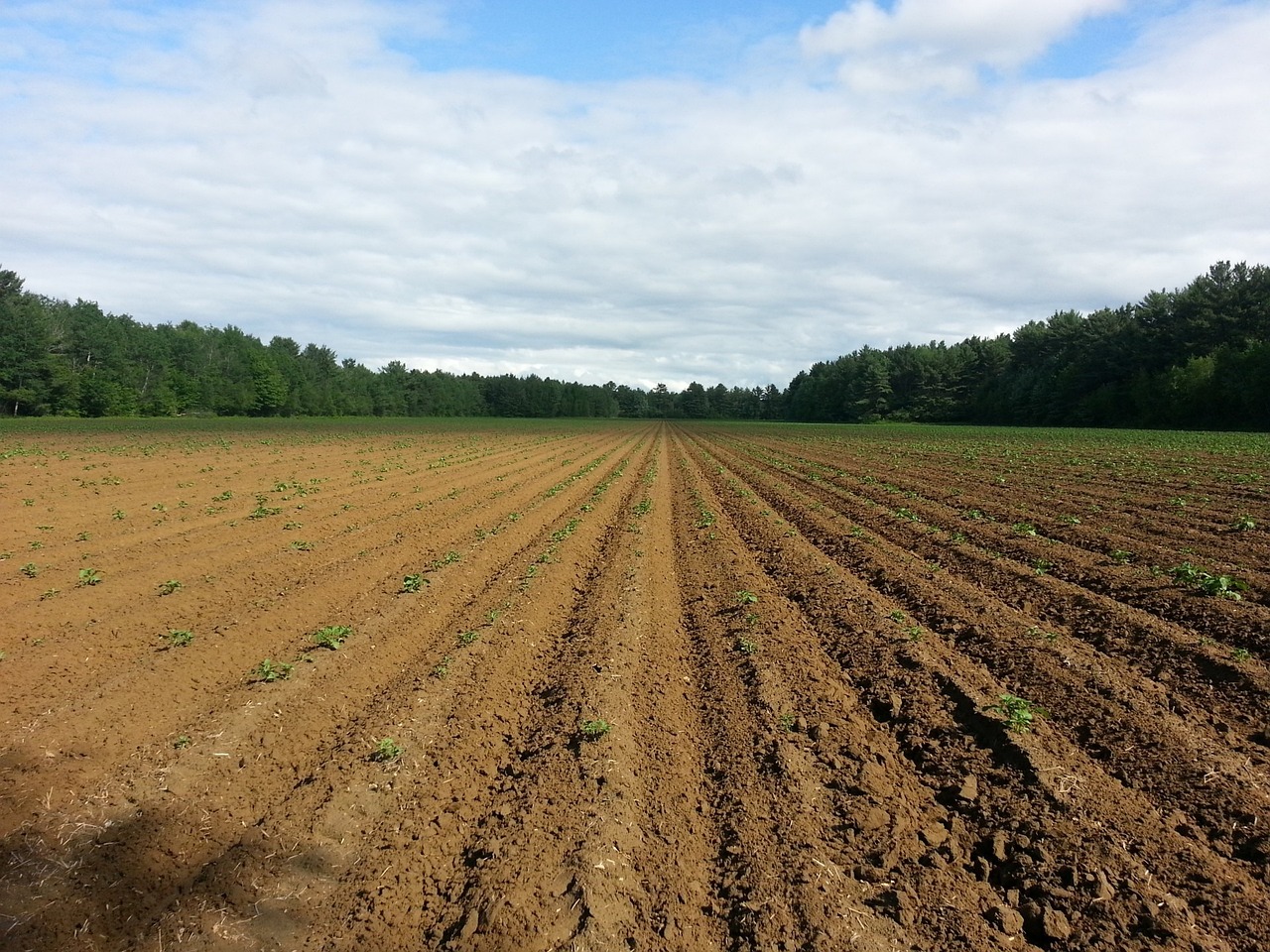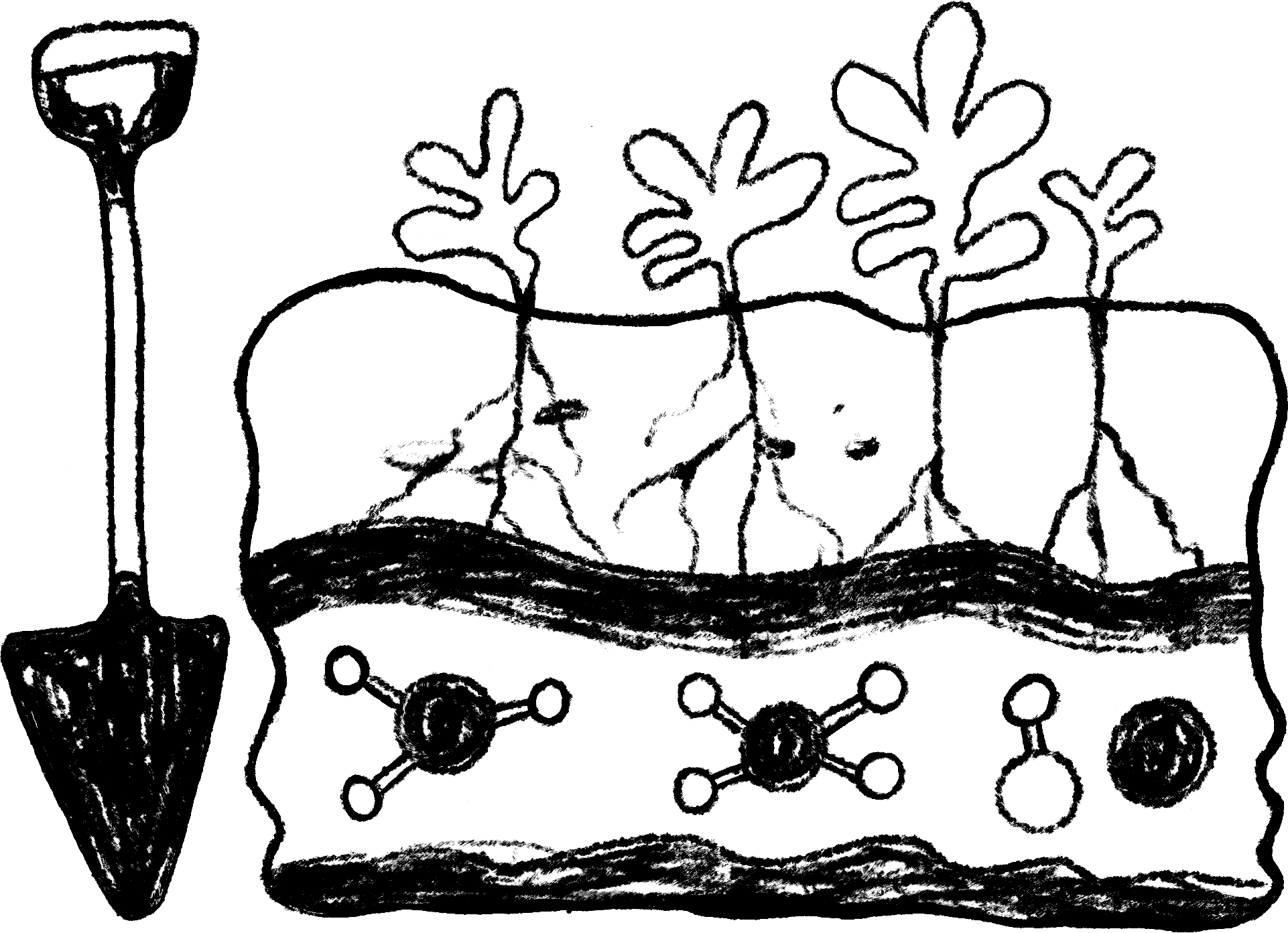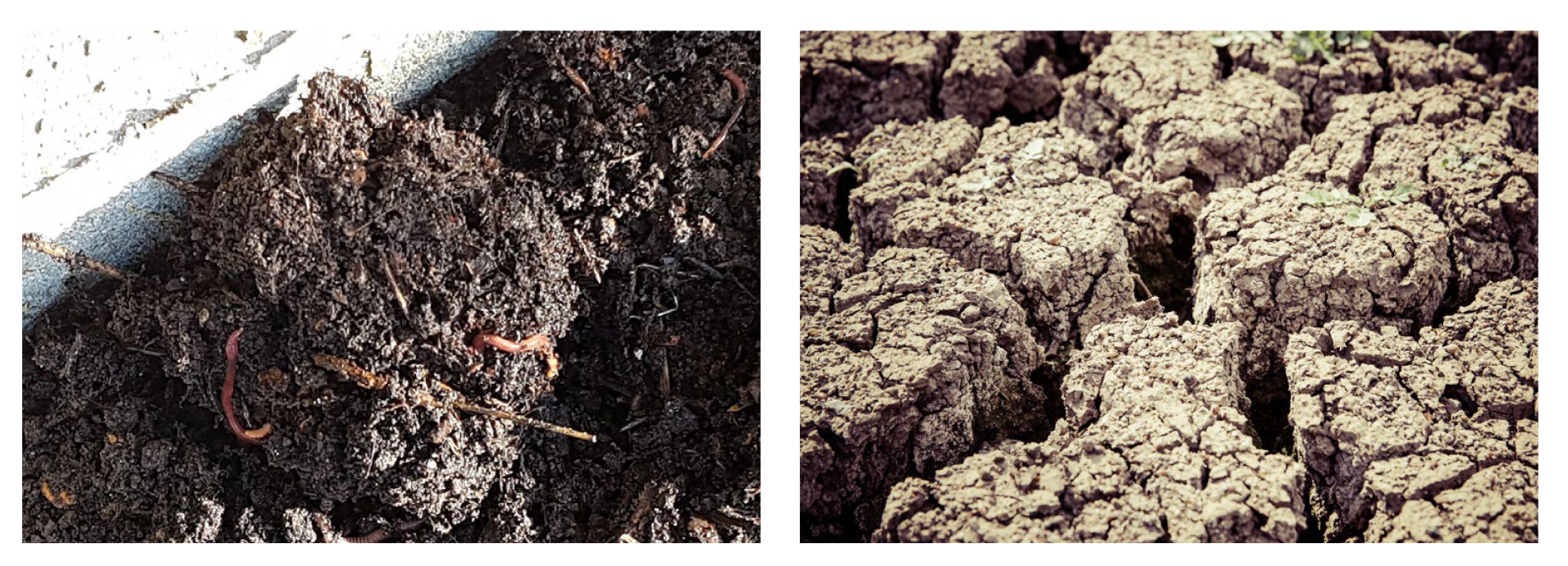Soil and Sustainability (Grades 9-12)
Students observe soil ecosystems to investigate how human impact affects the biodiversity of soils using the Simpson's Index of Diversity. Then, students conduct an investigation using field corn to determine how the introduction of nitrogen fertilizers impact soil microorganisms and biodiversity.

Background
Lesson Activities
Recommended Companion Resources
Credits
Author
Nourish the Future
Acknowledgements
This lesson is from the Soil and Sustainability unit created by Nourish the Future.
Standards
Texas Content Area Standards
-
Principles of Agriculture, Food, and Natural Resources: 130.2.c.1
The student demonstrates professional standards/employability skills as required by business and industry. The student is expected to:
- Principles of Agriculture, Food, and Natural Resources: 130.2.c.1.B: apply competencies related to resources, information, interpersonal skills, problem solving, critical thinking, and systems of operation in agriculture, food, and natural resources.
-
Principles of Agriculture, Food, and Natural Resources: 130.2.c.6
The student demonstrates appropriate personal and communication skills. The student is expected to:
- Principles of Agriculture, Food, and Natural Resources: 130.2.c.6.A: demonstrate written and oral communication skills appropriate for formal and informal situations such as prepared and extemporaneous presentations.
- Principles of Agriculture, Food, and Natural Resources: 130.2.c.6.B: demonstrate effective listening skills appropriate for formal and informal situations.
-
Principles of Agriculture, Food, and Natural Resources: 130.2.c.10
The student develops technical knowledge and skills related to soil systems. The student is expected to:
- Principles of Agriculture, Food, and Natural Resources: 130.2.c.10.A: identify the components and properties of soils.
- Principles of Agriculture, Food, and Natural Resources: 130.2.c.10.B: identify and describe the process of soil formation.
- Principles of Agriculture, Food, and Natural Resources: 130.2.c.10.C: conduct experiments related to soil chemistry.
-
World Geography Studies: 113.43.d.21
Social studies skills. The student applies critical-thinking skills to organize and use information acquired through established research methodologies from a variety of valid sources, including technology. The student is expected to:
- World Geography Studies: 113.43.d.21.F: formulate and communicate visually, orally, or in writing a claim supported by evidence and reasoning for an intended audience and purpose
-
Economics with Emphasis on the Free Enterprise System and Its Benefits: 113.31.d.21
Social studies skills. The student applies critical-thinking skills to organize and use information acquired through established research methodologies from a variety of valid sources, including technology. The student is expected to:
- Economics with Emphasis on the Free Enterprise System and Its Benefits: 113.31.d.21.F: formulate and communicate visually, orally, or in writing a claim supported by evidence and reasoning for an intended audience and purpose
-
English I: 110.36.c.1
Developing and sustaining foundational language skills: listening, speaking, discussion, and thinking--oral language. The student develops oral language through listening, speaking, and discussion.
- English I: 110.36.c.1.D: participate collaboratively, building on the ideas of others, contributing relevant information, developing a plan for consensus building, and setting ground rules for decision making
-
English I: 110.36.c.11
Inquiry and research: listening, speaking, reading, writing, and thinking using multiple texts. The student engages in both short-term and sustained recursive inquiry processes for a variety of purposes.
- English I: 110.36.c.11.F: synthesize information from a variety of sources
- English I: 110.36.c.11.I: use an appropriate mode of delivery, whether written, oral, or multimodal, to present results
-
English II: 110.37.c.1
Developing and sustaining foundation language skills: listening, speaking, discussion, and thinking--oral language. The student develops oral language through listening, speaking, and discussion.
- English II: 110.37.c.1.D: participate collaboratively, building on the ideas of others, contributing relevant information, developing a plan for consensus building, and setting ground rules for decision making
-
English III: 110.38.c.1
Developing and sustaining foundational language skills: listening, speaking, discussion, and thinking--oral language. The student develops oral language through listening, speaking, and discussion.
- English III: 110.38.c.1.D: participate collaboratively, offering ideas or judgments that are purposeful in moving the team toward goals, asking relevant and insightful questions, tolerating a range of positions and ambiguity in decision making, and evaluating the work of the group based on agreed-upon criteria
-
English II: 110.37.c.11
Inquiry and research: listening, speaking, reading, writing, and thinking using multiple texts. The student engages in both short-term and sustained recursive inquiry processes for a variety of purposes.
- English II: 110.37.c.11.F: synthesize information from a variety of sources
- English II: 110.37.c.11.I: use an appropriate mode of delivery, whether written, oral, or multimodal, to present results
-
English III: 110.38.c.11
Inquiry and research: listening, speaking, reading, writing, and thinking using multiple texts. The student engages in both short-term and sustained recursive inquiry processes for a variety of purposes.
- English III: 110.38.c.11.F: synthesize information from a variety of sources
- English III: 110.38.c.11.I: use an appropriate mode of delivery, whether written, oral, or multimodal, to present results
-
English IV: 110.39.c.1
Developing and sustaining foundational language skills: listening, speaking, discussion, and thinking--oral language. The student develops oral language through listening, speaking, and discussion.
- English IV: 110.39.c.1.D: participate collaboratively, offering ideas or judgments that are purposeful in moving the team toward goals, asking relevant and insightful questions, tolerating a range of positions and ambiguity in decision making, and evaluating the work of the group based on agreed-upon criteria
-
English IV: 110.39.c.11
Inquiry and research: listening, speaking, reading, writing, and thinking using multiple texts. The student engages in both short-term and sustained recursive inquiry processes for a variety of purposes.
- English IV: 110.39.c.11.F: synthesize information from a variety of sources
- English IV: 110.39.c.11.I: use an appropriate mode of delivery, whether written, oral, or multimodal, to present results
-
Algebra I: 111.39.c.1
Mathematical process standards. The student uses mathematical processes to acquire and demonstrate mathematical understanding.
- Algebra I: 111.39.c.1.A: apply mathematics to problems arising in everyday life, society, and the workplace
- Algebra I: 111.39.c.1.B: use a problem-solving model that incorporates analyzing given information, formulating a plan or strategy, determining a solution, justifying the solution, and evaluating the problem-solving process and the reasonableness of the solution
- Algebra I: 111.39.c.1.E: create and use representations to organize, record, and communicate mathematical ideas
-
Statistics: 111.47.c.1
Mathematical process standards. The student uses mathematical processes to acquire and demonstrate mathematical understanding.
- Statistics: 111.47.c.1.A: apply mathematics to problems arising in everyday life, society, and the workplace
- Statistics: 111.47.c.1.B: use a problem-solving model that incorporates analyzing given information, formulating a plan or strategy, determining a solution, justifying the solution, and evaluating the problem-solving process and the reasonableness of the solution
- Statistics: 111.47.c.1.C: select tools, including real objects, manipulatives, paper and pencil, and technology as appropriate, and techniques, including mental math, estimation, and number sense as appropriate, to solve problems
- Statistics: 111.47.c.1.D: communicate mathematical ideas, reasoning, and their implications using multiple representations, including symbols, diagrams, graphs, and language as appropriate
-
Statistics: 111.47.c.5
Probability and random variables. The student applies the mathematical process standards to connect probability and statistics.
- Statistics: 111.47.c.5.A: determine probabilities, including the use of a two-way table
-
Mathematical Models with Applications: 111.43.c.9
Mathematical modeling in social sciences. The student applies mathematical processes and mathematical models to analyze data as it applies to social sciences.
- Mathematical Models with Applications: 111.43.c.9.A: interpret information from various graphs, including line graphs, bar graphs, circle graphs, histograms, scatterplots, dot plots, stem-and-leaf plots, and box and whisker plots, to draw conclusions from the data and determine the strengths and weaknesses of conclusions
-
Advanced Quantitative Reasoning: 111.44.c.1
Mathematical process standards. The student uses mathematical processes to acquire and demonstrate mathematical understanding.
- Advanced Quantitative Reasoning: 111.44.c.1.A: apply mathematics to problems arising in everyday life, society, and the workplace
- Advanced Quantitative Reasoning: 111.44.c.1.B: use a problem-solving model that incorporates analyzing given information, formulating a plan or strategy, determining a solution, justifying the solution, and evaluating the problem-solving process and the reasonableness of the solution
- Advanced Quantitative Reasoning: 111.44.c.1.E: create and use representations to organize, record, and communicate mathematical ideas
-
Range Ecology and Management: 130.19.C.5
The student analyzes the biotic and abiotic components of a rangeland. The student is expected to:
- Range Ecology and Management: 130.19.C.5.A: discuss components of rangeland with an emphasis on soil.
- Range Ecology and Management: 130.19.C.5.B: determine components of rangeland with an emphasis on topography.
-
Advanced Plant and Soil Science: 130.25.c.1
The student demonstrates professional standards/employability skills as required by business and industry. The student is expected to:
- Advanced Plant and Soil Science: 130.25.c.1.B: apply competencies related to resources, information, interpersonal skills, and systems of operation in plant systems.
-
World History Studies: 113.42.d.28
Social studies skills. The student understands how historians use historiography to interpret the past and applies critical-thinking skills to organize and use information acquired from a variety of valid sources, including technology. The student is expected to:
- World History Studies: 113.42.d.28.F: formulate and communicate visually, orally, or in writing a claim supported by evidence and reasoning for an intended audience and purpose
-
Advanced Plant and Soil Science: 130.25.c.6
The student analyzes plant and soil science as it relates to plant and soil relationships affecting the production of food, fiber, and other economic crops. The student is expected to:
- Advanced Plant and Soil Science: 130.25.c.6.A: explain the importance and interrelationship of soil and plants.
-
Advanced Plant and Soil Science: 130.25.c.7
The student develops scenarios for advances in plant and soil science. The student is expected to:
- Advanced Plant and Soil Science: 130.25.c.7.A: design, conduct, and complete research in a laboratory or field investigation to solve problems in plant and soil science.
- Advanced Plant and Soil Science: 130.25.c.7.B: use charts, tables, and graphs to prepare written summaries of results and data obtained in a laboratory or field investigation.
- Advanced Plant and Soil Science: 130.25.c.7.C: organize, analyze, evaluate, make inferences, and predict trends from data obtained in a laboratory or field investigation.
- Advanced Plant and Soil Science: 130.25.c.7.D: communicate valid outcomes and solutions.
-
Advanced Plant and Soil Science: 130.25.c.9
The student analyzes soil science as it relates to food and fiber production. The student is expected to:
- Advanced Plant and Soil Science: 130.25.c.9.A: explain soil formation.
- Advanced Plant and Soil Science: 130.25.c.9.B: evaluate the properties and nature of soils.
-
Biology: 112.42.c.1
Scientific and engineering practices. The student, for at least 40% of instructional time, asks questions, identifies problems, and plans and safely conducts classroom, laboratory, and field investigations to answer questions, explain phenomena, or design solutions using appropriate tools and models. The student is expected to:
- Biology: 112.42.c.1.A: ask questions and define problems based on observations or information from text, phenomena, models, or investigations
- Biology: 112.42.c.1.B: use scientific practices to plan and conduct descriptive, comparative, and experimental investigations and use engineering practices to design solutions to problems
-
Biology: 112.42.c.13
Science concepts--interdependence within environmental systems. The student knows that interactions at various levels of organization occur within an ecosystem to maintain stability. The student is expected to:
- Biology: 112.42.c.13.B: analyze how ecosystem stability is affected by disruptions to the cycling of matter and flow of energy through trophic levels using models
- Biology: 112.42.c.13.D: explain how environmental change, including change due to human activity, affects biodiversity and analyze how changes in biodiversity impact ecosystem stability
-
Environmental Systems: 112.50.c.1
Scientific and engineering practices. The student, for at least 40% of instructional time, asks questions, identifies problems, and plans and safely conducts classroom, laboratory, and field investigations to explain phenomena or design solutions using appropriate tools and models. The student is expected to:
- Environmental Systems: 112.50.c.1.A: ask questions and define problems based on observations or information from text, phenomena, models, or investigations
-
Environmental Systems: 112.50.c.5
Science concepts. The student knows the relationships of biotic and abiotic factors within habitats, ecosystems, and biomes. The student is expected to:
- Environmental Systems: 112.50.c.5.A: identify native plants and animals within a local ecosystem and compare their roles to those of plants and animals in other biomes, including aquatic, grassland, forest, desert, and tundra
- Environmental Systems: 112.50.c.5.C: evaluate the effects of fluctuations in abiotic factors on local ecosystems and local biomes
- Environmental Systems: 112.50.c.5.D: measure the concentration of dissolved substances such as dissolved oxygen, chlorides, and nitrates and describe their impacts on an ecosystem
- Environmental Systems: 112.50.c.5.E: use models to predict how the introduction of an invasive species may alter the food chain and affect existing populations in an ecosystem
- Environmental Systems: 112.50.c.5.F: use models to predict how species extinction may alter the food chain and affect existing populations in an ecosystem
- Environmental Systems: 112.50.c.5.G: predict changes that may occur in an ecosystem if genetic diversity is increased or decreased
-
Environmental Systems: 112.50.c.6
Science concepts. The student knows the interrelationships among the resources within the local environmental system. The student is expected to:
- Environmental Systems: 112.50.c.6.A: compare and contrast land use and management methods and how they affect land attributes such as fertility, productivity, economic value, and ecological stability
- Environmental Systems: 112.50.c.6.B: relate how water sources, management, and conservation affect water uses and quality
- Environmental Systems: 112.50.c.6.D: identify how changes in limiting resources such as water, food, and energy affect local ecosystems
-
Environmental Systems: 112.50.c.7
Science concepts. The student knows the sources and flow of energy through an environmental system. The student is expected to:
- Environmental Systems: 112.50.c.7.D: identify and describe how energy is used, transformed, and conserved as it flows through ecosystems
-
Environmental Systems: 112.50.c.8
Science concepts. The student knows the relationship between carrying capacity and changes in populations and ecosystems. The student is expected to:
- Environmental Systems: 112.50.c.8.B: identify factors that may alter carrying capacity such as disease; natural disaster; available food, water, and livable space; habitat fragmentation; and periodic changes in weather
-
Environmental Systems: 112.50.c.9
Science concepts. The student knows that environments change naturally. The student is expected to:
- Environmental Systems: 112.50.c.9.C: examine how natural processes such as succession and feedback loops can restore habitats and ecosystems
-
Environmental Systems: 112.50.c.10
Science concepts. The student knows how humans impact environmental systems through emissions and pollutants. The student is expected to:
- Environmental Systems: 112.50.c.10.A: identify sources of emissions in air, soil, and water, including point and nonpoint sources
- Environmental Systems: 112.50.c.10.B: distinguish how an emission becomes a pollutant based on its concentration, toxicity, reactivity, and location within the environment
- Environmental Systems: 112.50.c.10.C: investigate the effects of pollutants such as chlorofluorocarbons, greenhouse gases, pesticide runoff, nuclear waste, aerosols, metallic ions, and heavy metals, as well as thermal, light, and noise pollution
- Environmental Systems: 112.50.c.10.D: evaluate indicators of air, soil, and water quality against regulatory standards to determine the health of an ecosystem
- Environmental Systems: 112.50.c.10.E: distinguish between the causes and effects of global warming and ozone depletion, including the causes, the chemicals involved, the atmospheric layer, the environmental effects, the human health effects, and the relevant wavelengths on the electromagnetic spectrum (IR and UV)
-
Environmental Systems: 112.50.c.11
Science concepts. The student understands how individual and collective actions impact environmental systems. The student is expected to:
- Environmental Systems: 112.50.c.11.A: evaluate the negative effects of human activities on the environment, including overhunting, overfishing, ecotourism, all-terrain vehicles, and personal watercraft
- Environmental Systems: 112.50.c.11.B: evaluate the positive effects of human activities on the environment, including habitat restoration projects, species preservation efforts, nature conservancy groups, game and wildlife management, and ecotourism
- Environmental Systems: 112.50.c.11.C: research the advantages and disadvantages of "going green" such as organic gardening and farming, natural methods of pest control, hydroponics, xeriscaping, energy-efficient homes and appliances, and hybrid cars.
-
Environmental Systems: 112.50.c.12
Science concepts. The student understands how ethics and economic priorities influence environmental decisions. The student is expected to:
- Environmental Systems: 112.50.c.12.A: evaluate cost-benefit trade-offs of commercial activities such as municipal development, food production, deforestation, over-harvesting, mining, and use of renewable and non-renewable energy sources;
- Environmental Systems: 112.50.c.12.B: evaluate the economic impacts of individual actions on the environment such as overbuilding, habitat destruction, poaching, and improper waste disposal
-
Chemistry: 112.43.c.1
Scientific and engineering practices. The student, for at least 40% of instructional time, asks questions, identifies problems, and plans and safely conducts classroom, laboratory, and field investigations to answer questions, explain phenomena, or design solutions using appropriate tools and models. The student is expected to:
- Chemistry: 112.43.c.1.A: ask questions and define problems based on observations or information from text, phenomena, models, or investigations
- Chemistry: 112.43.c.1.B: apply scientific practices to plan and conduct descriptive, comparative, and experimental investigations and use engineering practices to design solutions to problems
-
Chemistry: 112.43.c.9
Science concepts. The student understands how matter is accounted for in chemical reactions. The student is expected to:
- Chemistry: 112.43.c.9.B: differentiate among acid-base reactions, precipitation reactions, and oxidation-reduction reactions
 Systems thinking has been used to describe ecosystems and various processes in agriculture and the environment for a long time. Systems thinking can be described as looking at the interconnected parts of a whole. Each part can be labeled as one of four aspects: inputs, things that are added to the system from outside the system; outputs, the things produced from the system; storages, the places where some of the inputs are incorporated, or stored for future use; and flows, the movement of the matter and energy between the parts. Each one of these aspects is usually balanced by another in order for the system to maintain equilibrium or to stay in balance.
Systems thinking has been used to describe ecosystems and various processes in agriculture and the environment for a long time. Systems thinking can be described as looking at the interconnected parts of a whole. Each part can be labeled as one of four aspects: inputs, things that are added to the system from outside the system; outputs, the things produced from the system; storages, the places where some of the inputs are incorporated, or stored for future use; and flows, the movement of the matter and energy between the parts. Each one of these aspects is usually balanced by another in order for the system to maintain equilibrium or to stay in balance.
